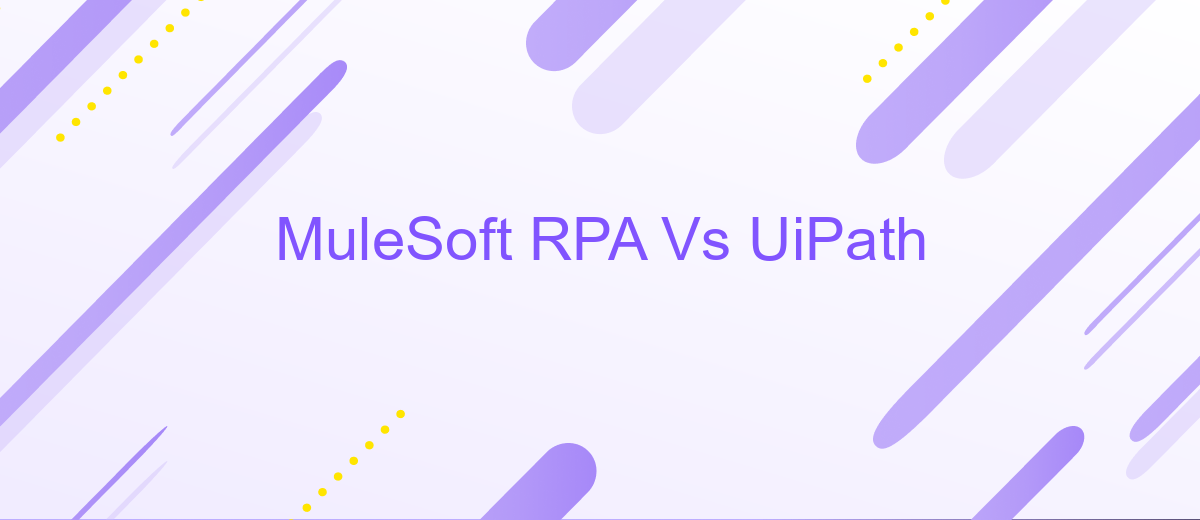MuleSoft RPA Vs UiPath
In today’s rapidly evolving technological landscape, businesses are increasingly turning to Robotic Process Automation (RPA) to streamline operations and enhance productivity. Two leading platforms in this domain are MuleSoft RPA and UiPath. This article aims to provide a comprehensive comparison of these two RPA solutions, highlighting their features, strengths, and potential use cases to help you make an informed decision.
Introduction
Robotic Process Automation (RPA) has become a cornerstone for businesses looking to automate repetitive tasks and improve efficiency. Two of the leading platforms in this field are MuleSoft RPA and UiPath. Both offer robust solutions, but they cater to different needs and come with their own sets of advantages and limitations.
- MuleSoft RPA: Known for its strong integration capabilities, especially with APIs.
- UiPath: Offers a user-friendly interface and extensive community support.
Choosing the right RPA tool is crucial for maximizing productivity and achieving seamless automation. While MuleSoft excels in API integrations, supported by services like ApiX-Drive, UiPath stands out for its ease of use and extensive resources. Understanding these differences can help businesses make an informed decision that aligns with their automation goals.
Functionality and Features

MuleSoft RPA and UiPath both offer robust functionality and features that cater to a wide range of automation needs. MuleSoft RPA excels in its seamless integration capabilities, leveraging the power of the Anypoint Platform to connect various applications and data sources. This makes it particularly strong in scenarios where complex integrations are required. On the other hand, UiPath is renowned for its user-friendly interface and extensive library of pre-built automation components, which significantly reduce the time needed to deploy automation solutions. Both platforms support extensive API integrations, but MuleSoft's strength lies in its deep-rooted connectivity options, making it a preferred choice for enterprises with diverse and complex IT ecosystems.
One of the standout features of MuleSoft RPA is its ability to handle intricate data transformations and real-time processing, which is critical for businesses that require up-to-the-minute information. UiPath, however, shines in its advanced AI and machine learning capabilities, enabling more intelligent and adaptive automation processes. For those looking to streamline integration processes, services like ApiX-Drive can be invaluable, offering easy-to-use tools for setting up and managing integrations without requiring deep technical expertise. Ultimately, the choice between MuleSoft RPA and UiPath will depend on the specific needs and technical landscape of the organization.
Pricing and Licensing

When it comes to pricing and licensing, MuleSoft RPA and UiPath offer distinct models to cater to different business needs. MuleSoft RPA generally operates on a subscription-based model, which can be tailored based on the number of bots and the level of support required. This flexibility allows businesses to scale their RPA solutions as they grow.
- MuleSoft RPA: Subscription-based model with customizable options based on bots and support.
- UiPath: Offers a tiered pricing structure, including a free tier, standard, and enterprise plans.
UiPath provides a more tiered pricing structure, which includes a free tier for small projects or trials, as well as standard and enterprise plans that offer advanced features and support. Both platforms also support integrations with various third-party services, such as ApiX-Drive, which can help streamline the setup and management of these integrations, ensuring a smoother RPA implementation process.
Use Cases and Applications

Robotic Process Automation (RPA) solutions like MuleSoft RPA and UiPath are transforming the way businesses operate by automating repetitive tasks and workflows. Both platforms offer unique strengths and are suitable for a variety of use cases across different industries.
MuleSoft RPA excels in integrating disparate systems and applications, making it ideal for complex enterprise environments. It is particularly useful for automating data synchronization between CRM, ERP, and other business systems. On the other hand, UiPath is known for its user-friendly interface and extensive library of pre-built automation components, making it accessible for businesses of all sizes.
- Data entry and extraction
- Invoice processing
- Customer service automation
- HR onboarding processes
- Financial report generation
For businesses looking to streamline their integration processes, services like ApiX-Drive can complement RPA solutions by offering seamless API integrations without the need for extensive coding. This can further enhance the efficiency and scalability of automated workflows, allowing organizations to focus on strategic initiatives rather than manual tasks.
Conclusion
In conclusion, both MuleSoft RPA and UiPath offer robust solutions for automating business processes, each with its unique strengths. MuleSoft excels in its seamless integration capabilities, making it an ideal choice for organizations looking to streamline their API management and connect various systems efficiently. On the other hand, UiPath stands out with its user-friendly interface and extensive library of pre-built automation components, catering to businesses that prioritize ease of use and rapid deployment.
Ultimately, the choice between MuleSoft RPA and UiPath depends on the specific needs and priorities of your organization. For those seeking comprehensive integration solutions, leveraging services like ApiX-Drive can further enhance MuleSoft's capabilities, providing an additional layer of flexibility and efficiency. Meanwhile, UiPath's extensive automation tools are perfect for businesses aiming to optimize their workflows quickly and effectively. By carefully assessing your requirements, you can select the platform that best aligns with your business goals and operational demands.
- Automate the work of an online store or landing
- Empower through integration
- Don't spend money on programmers and integrators
- Save time by automating routine tasks
FAQ
What are the main differences between MuleSoft RPA and UiPath?
Which platform is better for integrating multiple enterprise systems?
Can both MuleSoft RPA and UiPath be used together?
What are the typical use cases for MuleSoft RPA?
How do I get started with implementing automation solutions using MuleSoft RPA or UiPath?
Apix-Drive is a universal tool that will quickly streamline any workflow, freeing you from routine and possible financial losses. Try ApiX-Drive in action and see how useful it is for you personally. In the meantime, when you are setting up connections between systems, think about where you are investing your free time, because now you will have much more of it.


